Image via Pirates Wiki
The Pirates of the Caribbean ride at Disneyland recently celebrated its 50th anniversary. The attraction has a timeless appeal, and its greatest strength was its lack of storyline. But then, Disney added Jack Sparrow to the ride in 2006. Sparrow’s inclusion, and the intrusive manner in which it was done, detracts from what made the ride special.
Pirates of the Caribbean has the distinction of being one of the few active rides Walt Disney had input on before he died. According to Disney developer Jason Surrell, who wrote the book Pirates of the Caribbean: From the Magic Kingdom to the Movies, Walt initially envisioned the Pirates attraction as a walkthrough narrated by a tour guide, with wax figures of famous pirates. But ride technology improved so much by 1963 that, after the success of the It’s A Small World boat ride at the New York World’s Fair, Walt decided that a proper ride, with real boats and real water, would be the best.
Disney left the creative groundwork to developer Marc Davis, who is known in Disney circles for his flighty, humorous approach to design. Here is one of his typical sketches:
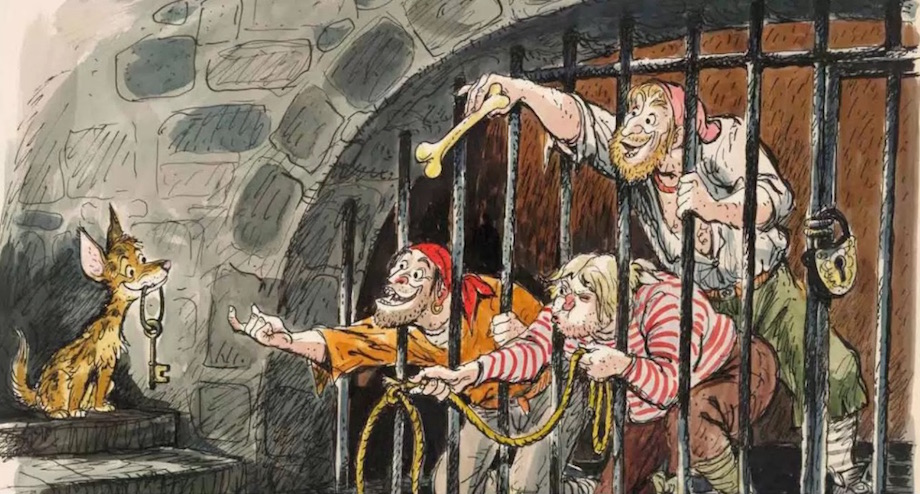
Image via Disney Books
This sketch eventually became an iconic part of the Pirates of the Caribbean ride, seen below.
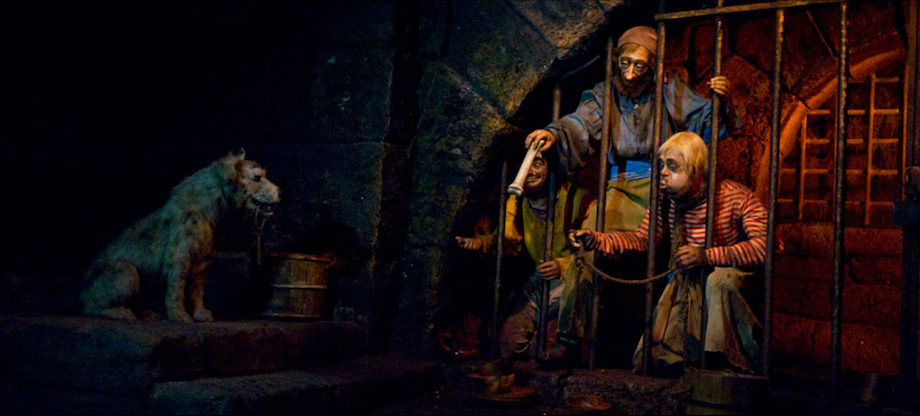
Image via Pirates Wiki
This ride scene would eventually feature in the first Pirates of the Caribbean film, The Curse of the Black Pearl.
According to Surrell, Davis originally intended to portray pirates realistically, with depictions of famous pirates of the Golden Age. The more Davis researched, however, the more he realised that real pirates were much less glamorous than he had anticipated. Pirates rarely battled at sea. They were as likely to die from a venereal disease as from a rapier wound.
So Davis pivoted to the more whimsical, romanticized approach that audiences enjoy today. The pirates have a caricatured, rounded appearance that makes them softer and less threatening to a young audience.
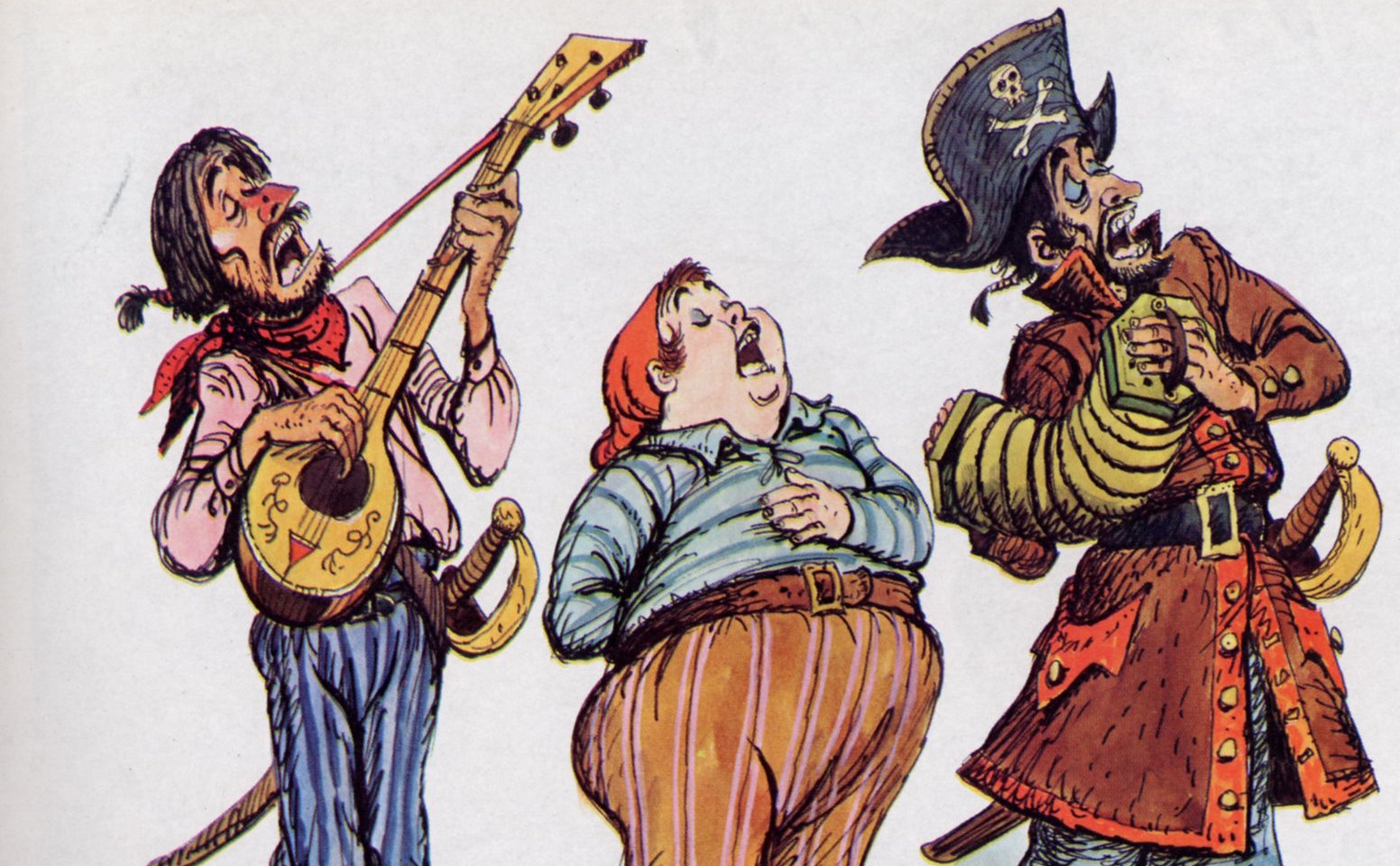
Image via Disney History Institute
Before riders see these pirates, though, they’re treated to wordless scenery. Like The Haunted Mansion, Pirates of the Caribbean opens with evocative visual imagery: a series of tableaus featuring pirate skeletons, locked eternally into the moments of their demises.
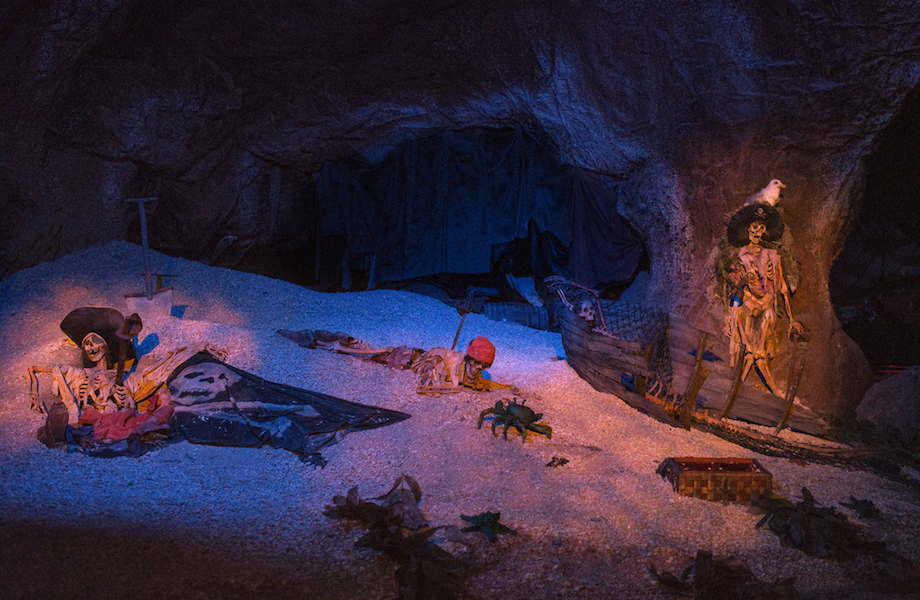
Image via Pirates Wiki
This still life tells a clear story: Money corrupts. There is no honour among thieves. The scenery speaks for itself; we don’t need to be spoon-fed the story.
It isn’t the story of any one pirate, either. Together, these skeletons paint a rich picture of the pitfalls of useless greed. A skeleton sits perched on top of a mountain of treasure. A skeleton is tucked into a lavish bed, surrounded by decadence. Despite their riches, mostly unspent, these pirates ended up the same way — as dead as everyone else.
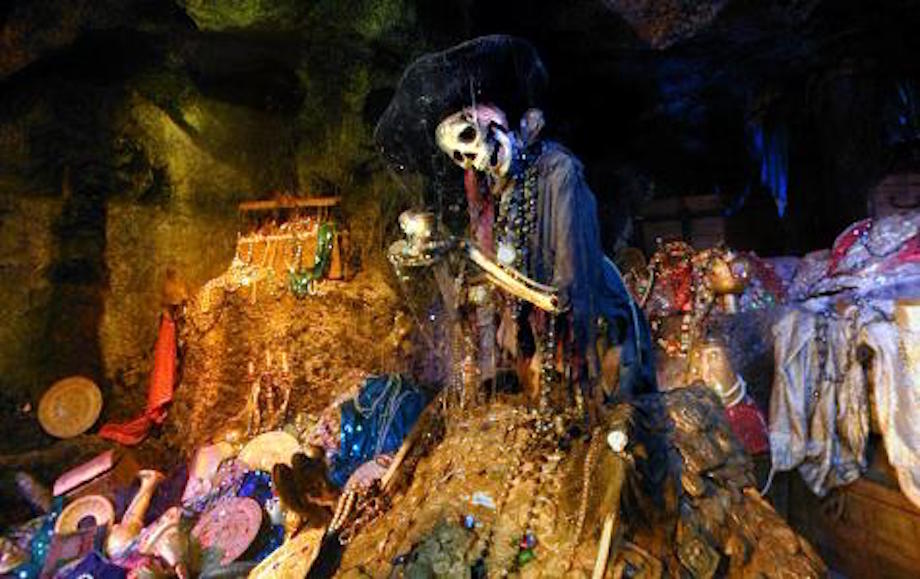
Image via Pirates Wiki
Some of the skeletons move, implying that they are damned men, cursed with repeating their life’s actions through the eons. Like this skeleton, who guzzles red wine into his non-existent belly. It was a brief respite of humour, despite the overall eeriness of the presentation.
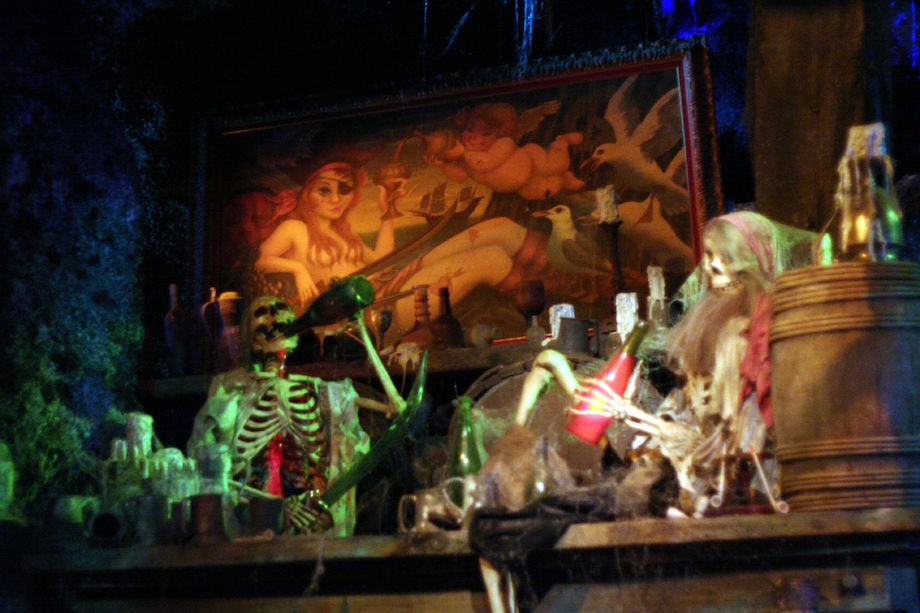
Image via Pirates Wiki
Then, the guests’ boat slid down a slight incline, and guests went further back in time to when these skeleton pirates had flesh on their bones. Until 2006, Pirates of the Caribbean wasn’t a narrative ride like Splash Mountain, which told a cohesive, sequential tale of Br’er Rabbit and his beloved Briar Patch. Instead, guests floated through a coastal town as it was being invaded. It was an immersive experience of what it was like to be a pirate, rather than a linear, A to B story.
Visitors didn’t see a pirate in one scene, and then see the same pirate in another scene, advancing his plot. Instead, they saw all manner of pirates, doing all manner of things, in different parts of the town. Since no one pirate was the focus, all the pirates were the focus. The audience members had their heads on swivels, trying to take in every last detail. No one ride was exactly the same for any two audience members.
But in 2006, Disney announced they were adding Captain Jack Sparrow to the ride. He had become so identifiable with the Pirates of the Caribbean brand that it seemed inevitable.
The Jack Sparrow robot (Disney calls them “Audio-Animatronics”) looks uncannily like Johnny Depp. He stands out from the cartoonish pirates that surround him. A caricature of Depp in Davis’ style would have blended in, and that was not what Disney wanted from this change.
While the initial skeleton tableaus were left untouched, Disney overhauled the town scenes to fit Sparrow in. Sparrow, unlike any other pirate, appears three times. First, he appears at the well-dunking scene, peering out from behind some mannequins. Later, he hides in a barrel and peeks at a treasure map another pirate is holding. And finally, he lounges in a chair at the end of the ride, celebrating with his new treasure. In Walt Disney World, Sparrow actually replaces the original, drunken pirates in this final scene.
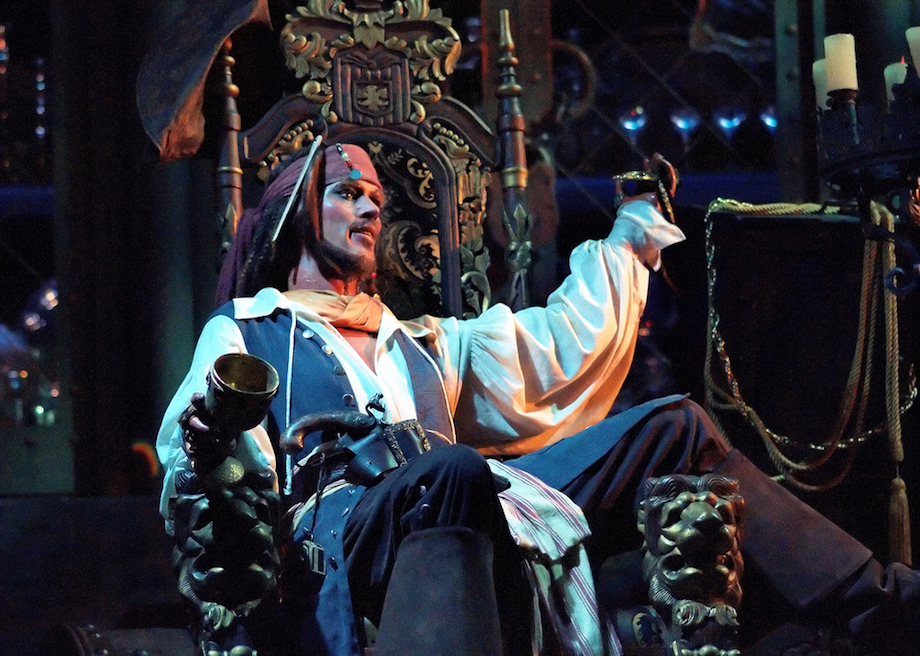
Image via Pirates Wiki
Together, these multiple appearances turn the ride into a version of Where’s Waldo? as far as riders are concerned. The last time I rode Walt Disney World’s Pirates of the Caribbean was in 2012. I was chaperoning a class trip for my students, and so I was sitting in the back of the boat. Every time Sparrow made an appearance, my kids would point and stare, neglecting everything but the celebrity they recognised. Sparrow appears twice in large crowd scenes, where the audience will miss out on numerous wonderful details if they just zero in on spotting him. By adding him into the ride in this way, the entire experience of Pirates of the Caribbean has changed. The experience becomes less exploratory of the little side-narratives and more directed towards A Big Plot.
The changes to accommodate Jack Sparrow don’t end there. Some of the pirates’ lines were re-recorded to draw attention to Sparrow’s presence in the ride. Rather than looking for treasure, every pirate in the attraction is looking for Jack Sparrow. Here’s the pre-2006 line of the pirate captain firing upon the fort:
Fire at will! Stand by at your guns, mates! Strike your colours, ya bloomin’ cockroaches! By thunder, we’ll see ya to Davy Jones! Surrender, ya lily livered lubbers!
In the post-2006 version, the pirate captain has been replaced by the films’ Captain Barbossa — another impressive robot who looks like Geoffrey Rush — and he prioritises Sparrow over the treasure:
Strike your colours, ya bloomin’ cockroaches! Surrender Cap’n Jack Sparrow — or, by thunder, we’ll burn this city to the ground! It’s Cap’n Jack Sparrow we’re after — and a fortune in gold. Put up your white flag, ya scurvy scum. Bring me Cap’n Jack Sparrow, or I’ll be sendin’ ya to Davy Jones!
Immediately afterwards is a scene where a group of pirates tortures the town’s mayor by dunking him in a well. Here are the original lines:
“Speak up ya bilge rat! Where be the treasure?”
“Scuttle the old cockroach!”
“Hoist him aloft again matey. By gum, he’ll talk!”
And here are the new, re-recorded lines:
“Pipe the lubber aloft, matey. Where be Cap’n Jack Sparrow and the treasure, ya bilge rat?”
“Scuttle, ya bilge rat!”
“Take him aloft again, matey! Where be Cap’n Jack Sparrow? Speak up — or do you fancy a swim with Davy Jones?”
This is no longer Pirates of the Caribbean. This is Pirates of the Caribbean: The Search For Captain Jack. This new, linear narrative about Jack Sparrow trying to beat his fellow pirates to some treasure is far less interesting than the vague non-narrative that it replaced. Nothing is left to the imagination. The fanciful pirates and their adventures become the backdrop to Jack Sparrow. The audience is so honed in on a single pirate that they’re likely to miss the hundreds of other things going on throughout the ride. Every new guest now leaves the ride with a similar story to every other guest — how Jack Sparrow got the treasure — rather than a unique experience of pirates. And that’s a shame.
Updating attractions is important for keeping things fresh and relevant. Walt Disney said, “Disneyland will never be completed. It will continue to grow as long as there is imagination left in the world.” Some of the changes to the Pirates of the Caribbean ride — those not related to Jack Sparrow — have been good. For instance, a town scene originally had lustful pirates chasing after screaming women. In 1997, the women were given trays of food to carry, to create the impression that the pirates were hungry rather than horny. This went over badly with a lot of traditionalists, including the ride’s writer X. Atencio, who dubbed the changes “Boy Scouts of the Caribbean.”
The current attempt at fixing the scene has some of the women chasing after the men, who are carrying looted jewellery and other goodies. This type of revision appeals to changing social norms. Pirates of the Caribbean has benefitted from updates like these, as well as changes to its lighting, sound, and technology. But these sorts of changes do not alter the ride’s overall purpose, or change the way the guest is meant to interact with it. ‘The Search For Captain Jack’ does.
Disney has also shown this tendency in the Pirates of the Caribbean films.The first film, The Curse of the Black Pearl, made Jack Sparrow a supporting character. But the scenery-chewing Sparrow was so well-received and beloved (Depp actually scored an Oscar nomination for his performance) that he became the protagonist in three subsequent films: Dead Man’s Chest, At World’s End, and On Stranger Tides.
It’s not a good idea to make an eccentric free-spirit the protagonist of a fantasy film. For the upcoming new movie, Dead Men Tell No Tales, the directors learned from the previous films’ mistake. Joachim Rønning, who co-directed Dead Men Tell No Tales with Espen Sandberg, said in an interview with Total Film:
It was important to go back to the same dynamic that the first film had where Jack is not the main character. I wanted a story about real people, real characters – and then Jack Sparrow comes in and crashes the party every now and then.
The movie franchise was inspired by the ride. And now, fittingly, the ride need to take a lesson in restraint from the films. Pirates of the Caribbean’s recent changes shrink the original ride’s expansive experience, stifling the imagination rather than inspiring it. The ride is at its best when guests can dream up their own stories, instead of having one imposed upon them.
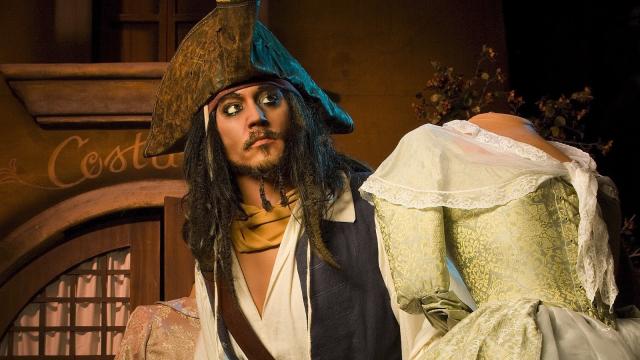
Comments
5 responses to “Jack Sparrow Ruined Disney’s Pirates Of The Caribbean Ride”
“Ruins it”? thats a bit dramatic and clicky-baity. Really detracts from an interesting read. Ruins it or brings a stale ride into another generation? probably a bit of both. it really comes down to taste but for better and worse Captain Jack has single-handedly had a huge impact on pirating in movies. It really is a testament to the character and his acting, it stands to reason, of course Disney is going to capitalise on him while he remains relevant. Until the next generation it changes again
It’s kind of his thing. Like the article talking about how Elmo ruined Sesame Street. Or how Snoopy ruined Peanuts.
All of them great reads, I’ll always have time for a Kevin Wong article.
I’ll go with Elmo ruining Sesame St.
It was only a stale ride in that it was showing its age and needed an overhaul and fresh coat of paint. I’ve been through it on many occasions both before and after the change and it’s a significantly worse ride now. Completely ruined? No. The push to put Jack Sparrow everywhere absolutely detracts from the experience if you had been through it before they made the change though.
It’s worse for me because I know I went there and saw it in ’98, but I totally recall Jack Sparrow being everywhere. I can only assume I’m thinking of my ’13 trip to Japan, and that’s overwritten whatever memories I had, if any :/